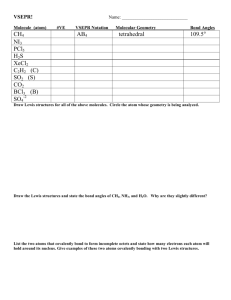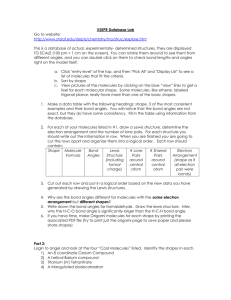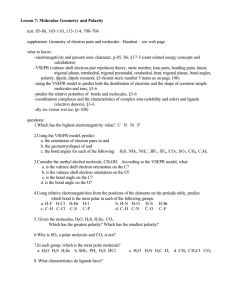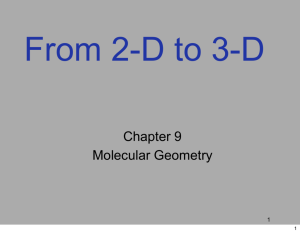VSEPR Notes
advertisement
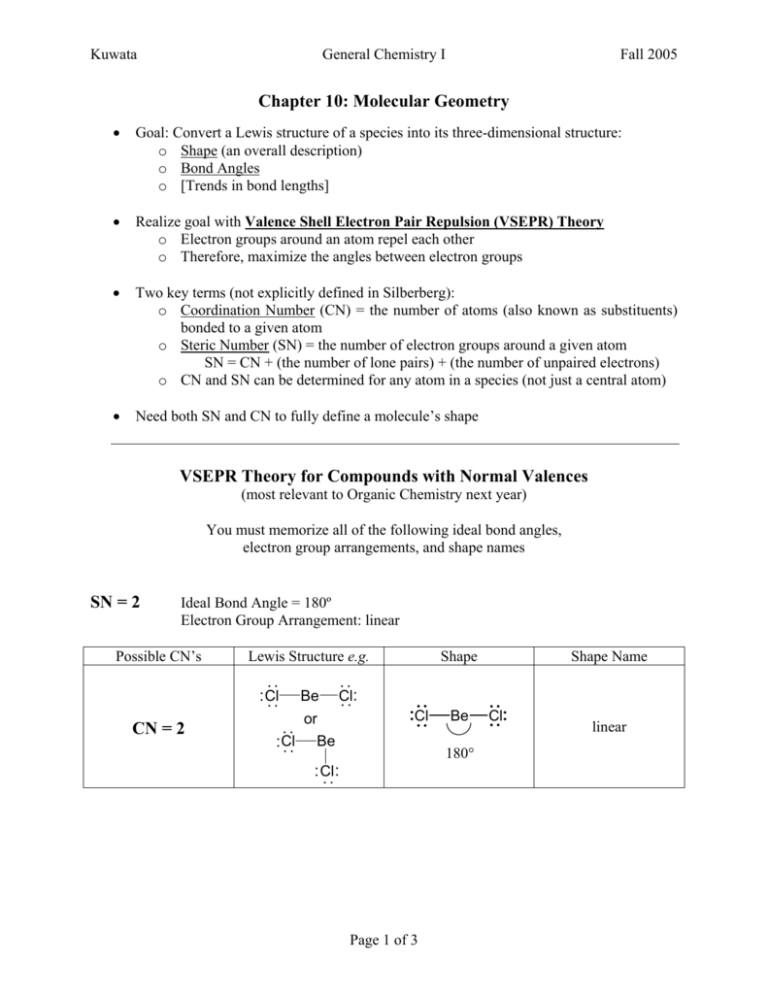
Kuwata General Chemistry I Fall 2005 Chapter 10: Molecular Geometry • Goal: Convert a Lewis structure of a species into its three-dimensional structure: o Shape (an overall description) o Bond Angles o [Trends in bond lengths] • Realize goal with Valence Shell Electron Pair Repulsion (VSEPR) Theory o Electron groups around an atom repel each other o Therefore, maximize the angles between electron groups • Two key terms (not explicitly defined in Silberberg): o Coordination Number (CN) = the number of atoms (also known as substituents) bonded to a given atom o Steric Number (SN) = the number of electron groups around a given atom SN = CN + (the number of lone pairs) + (the number of unpaired electrons) o CN and SN can be determined for any atom in a species (not just a central atom) • Need both SN and CN to fully define a molecule’s shape VSEPR Theory for Compounds with Normal Valences (most relevant to Organic Chemistry next year) You must memorize all of the following ideal bond angles, electron group arrangements, and shape names SN = 2 Ideal Bond Angle = 180º Electron Group Arrangement: linear Possible CN’s Lewis Structure e.g. Cl CN = 2 Be Shape Name Cl Cl or Cl Shape Be Be 180° Cl Page 1 of 3 Cl linear Kuwata SN = 3 General Chemistry I Ideal Bond Angle = 120º Electron Group Arrangement: trigonal planar Possible CN’s Lewis Structure e.g. CN = 3 H B H H CN = 2 Cl Sn Shape H Shape Name H B 120° H trigonal planar bent Cl (large Group 4A can have less than an octet) SN = 4 Fall 2005 Sn Cl Cl (names based on atom locations only) Ideal Bond Angle = 109.5º Electron Group Arrangement: tetrahedral Possible CN’s Lewis Structure e.g. CN = 4 H H C H H CN = 3 Shape 109.5° H H C H H N H H H H O H CN = 2 N H H H H O or H Shape Name tetrahedral trigonal pyramidal bent (but how similar is it to SnCl2?) H O H If for a given atom (1) SN = CN and (2) all substituents are identical, the actual (experimental) bond angles will be the same as the ideal bond angles (by symmetry). Page 2 of 3 Kuwata General Chemistry I Fall 2005 VSEPR Theory for Hypervalent Compounds Shape Names (ideal bond angles) Shape Names (ideal bond angles) Ideal Bond Angle = 90º Electron Group Arrangement: octahedral Ideal Bond Angles = 90º, 120º (180° for linear) Electron Group Arrangement: trigonal bipyramidal You are not required to memorize the shape names for SN = 5 and SN = 6. However, you should be able to explain the shapes and bond angles. Page 3 of 3

